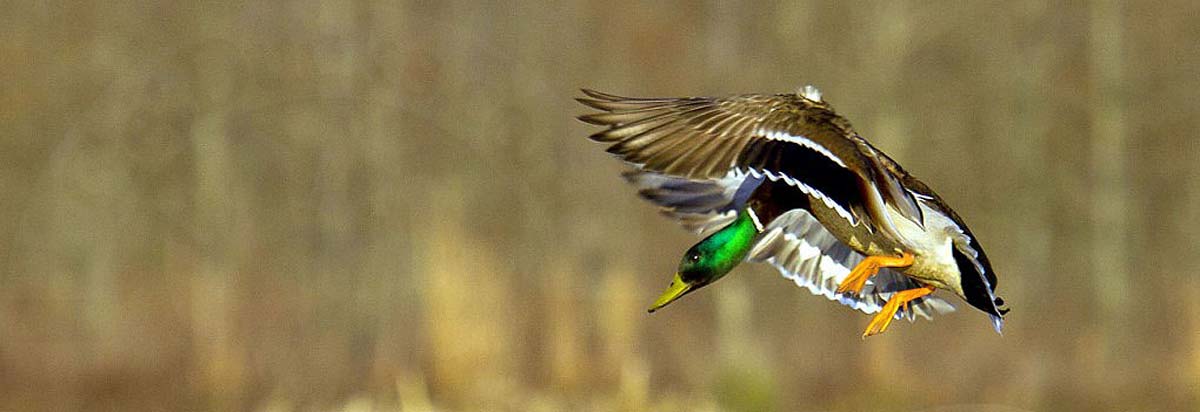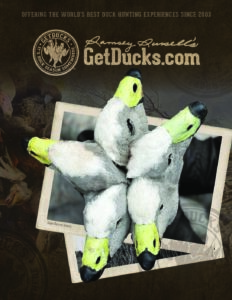Northern Shoveler
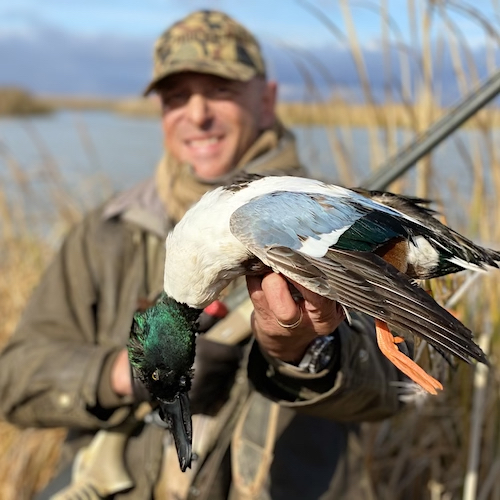
Northern Shoveler (Anas clypeata) is named for its conspicuously spatula-like bill (i.e. the Spatula genus). This is by far the most distinctive attribute that makes these medium-sized dabblers stand out. Drake northern shovelers tend to have black bill color, while hens possess the typical yellow-orange bill. Other defining characteristics for both sexes are yellow eyes, bright orange legs, and short tail. Identification during flight includes the “hunched” appearance of the body, relatively narrow wings and slow wingbeat. Similarly to other species within the Spatula genus, northern shovelers have prominent blue upper wing and flashy green speculum which are divided by a white line of plumage. As compared to blue-winged teal drakes, northern shoveler drake wings are distinguished by visibly white primary feather shafts. Drake northern shovelers have dark green-blue head and neck (darker than the typical mallard green), stark white chest, and blocky, light chestnut plumage directly under the wings. Hens are mottled brown.
Available Hunts
-
North Dakota Waterfowl Hunt
Dirty Bird Outfitters delivers the best guided North Dakota waterfowl hunting experiences. North Dakota duck hunts, North Dakota goose hunts and North Dakota swan hunts are their specialties.
...read more- Guided North Dakota duck hunting combo packages
- High-success North Dakota Swan Hunts (must draw tag)
- Early- and late-season North Dakota Canada Goose Hunting
- Packages include meals and lodging
- NEW Home-away-from-home lodge (constructed 2021)
- Small, highly experienced and professional staff
- Mallards, wigeons, pintails, cackler geese, Canada geese, white-fronted geese, light geese, tundra swans
- Waterfowl hunting opportunities August through mid-December
Rate: $400-650 daily -
Oklahoma Duck Hunt
Oklahoma duck hunting a little over an hour drive from Dallas - as good as it gets. We've promoted this hunt for a very long time, always happy client feedback.
...read moreExcellently guided Oklahoma duck hunts are located a little over an hour north from Dallas. Perfect opportunity for a morning hunt before work or an easy weekend hunt with friends, family or business associates.
- Located 1 to 1.5 hours from downtown Dallas
- Expertly-guided Oklahoma duck hunts, afternoon hog hunting available
- Oklahoma and Texas depending on bird activity
- Mostly dry blinds, waders not always needed
- Cabin accommodations for up to 8 can be provided
- Meals not included
Rate: $400 per morning -
Saskatchewan Canada Waterfowl Hunts
Prairie Limits Outfitters delivers superior Saskatchewan Canada waterfowl hunts in "The land of Living Skies."
...read moreDelivering consistently great Saskatchewan Canada waterfowl hunts is what Prairie Limits Outfitters does. Young energetic staff of go-getters are highly experienced.
- Mostly dry-field hunts for Canadas, cacklers, white-fronts, snows, mallards and pintails, sandhill cranes
- Choose between 3- or 5-day waterfowl hunting packages
- INCLUSIVE packages, choose either Fully Guided or Premier hunting experiences
- New lodge conveniently located to community amenities
- Fly into either Saskatoon SK or Edmonton AB
Rate: $2,800 and up -
Texas Duck Hunting – Gulf Coast Redheads and More
Run-N-Gun Adventures accesses the greatest percentage of the entire world’s population of overwintering redheads on nearby Laguna Madre and surrounding areas for the Texas duck hunting experience of a lifetime. But LOTS more, too.
...read more- Trophy Redheads on Matagorda Bay
- Pintail, teal, mottled ducks, black-bellied whistlers, white-fronts, snows and more
- 50,000+ acres exclusive, intensively managed properties
- Cast & Blast packages and afternoon hunts available
- NEW 11,000 sqft luxurious lodge, chef-prepared meals
- Located only 1 hour from Houston
Rate: $175-300 day rate/ $1,425 and up packages -
Texas Goose Hunting – Panhandle
Texas goose hunting the west Texas panhandle remains America's best kept secret. Countless, shallow playa lakes in a landscape of agriculture provides perfect overwintering habitat for thousands of geese, ducks and sandhill cranes.
...read more- High-success hunting (goose or crane limits are the norm)
- Canada geese, white-fronts, snows, ducks, sandhill cranes, and more
- Many exclusive hunting properties within 1-hour radius of Plainview
- Combos and afternoon hunts available
- Camp-house lodging available (not a hotel hunt)
Rate: $375 -
Texas Waterfowl Hunt – Desert Paradise
Texas waterfowl hunt packages features relatively unpressured ducks, geese and sandhill cranes in an area so large it takes 3 lodges to cover and so ecologically diverse that most Central Flyway waterfowl species can be hunted!
...read more- Inclusive Texas waterfowl hunting packages for ducks, geese, sandhill cranes, doves, early blue-winged teal, spring turkeys, more.
- 3 lodges to cover vast, relatively undisturbed waterfowl hunting area and to offer flexibility for desired bucket-list species, amenity-level needs, or personal budget
- Central flyway puddle ducks to include prized mottled duck, Mexican duck, cinnamon teal, fulvous whistling duck, black-bellied whistling duck opportunities all right here in USA
- Sandhill crane hunting and white-fronted goose hunting are the Speck Ops Waterfowl house specialties
- Luxurious lodging with over-the-top and fun activities provide fun for bachelor or business hunting groups, entire families and non-hunters,
Rate: $2,000 to $2,900
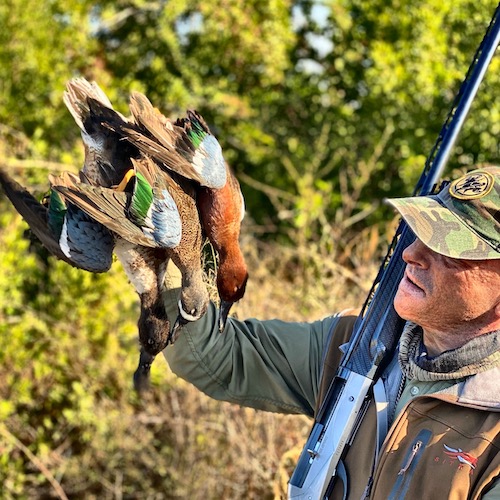
Northern shoveler breeding zone ranges from the western US, through Canada to Alaska. These birds can also be found breeding in Europe. Grassy fields are the preferred nesting habitat for this species. Habitat requirements for foraging are often fulfilled by shallow wetlands with plenty of vegetation. There, northern shovelers will keep their heads down and use their unique bills to filter seeds and small crustaceans from the water. This diet gives them the reputation of being unappetizing to eat, such that hunters in many locales will not shoot them. Most hunters agree that northern shovelers “taste like ducks,” especially when feeding in agriculture and other freshwater habitats.
Northern shoveler’s wintering zone includes western and Southern US, Arkansas, along coastlines and “across the pond” in Eurasia, northern Africa, and India. This species readily uses stagnant and murky types of waters, but also frequents estuaries, flooded fields, and lakes. During breeding season, these monogamous birds will choose their mate and remain with each other until fall migration begins. Throughout the United States and Canada, the northern shoveler represents the Rodney Dangerfield of waterfowl (“no respect”) as denoted by a long list of colloquial nicknames to include spoonie, smiling mallard, hollywood, bootleg, baloney snatcher, Ramzilla, etc. Yet elsewhere throughout the world that the northern shoveler is hunted, it is regarded as simply another duck species.
According to the U.S. Fish and Wildlife Service, Canadian Wildlife Service, and other partners, northern shoveler estimated total population for 2019 is 3.6 million. Despite the 13% decrease in Northern Shoveler populations in from 2018 to 2019, the overall population has increased by 39% in relation to long-term abundance studies.
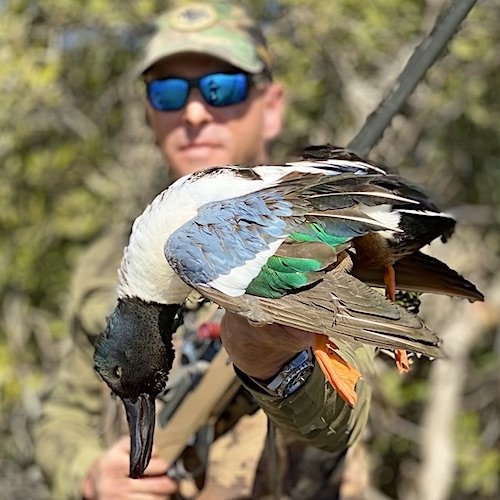 SPOON AND CROCKETT. Shovelers are the most ubiquitous species in western Mexico. Not the only species, but there are many. Not necessarily the most abundant, either. But they’re everywhere in Mexico. And of course I shoot ‘em plenty. They don’t call ‘em Ramzillas for nothing. All jokes and biases aside, they’re beautiful. And I think northern shovelers are one of the hardest puddle ducks to get a truly primo specimen.
SPOON AND CROCKETT. Shovelers are the most ubiquitous species in western Mexico. Not the only species, but there are many. Not necessarily the most abundant, either. But they’re everywhere in Mexico. And of course I shoot ‘em plenty. They don’t call ‘em Ramzillas for nothing. All jokes and biases aside, they’re beautiful. And I think northern shovelers are one of the hardest puddle ducks to get a truly primo specimen.
Seems like spoonies are “dirty” until their second adult breeding molt, at least, and i don’t think they complete their breeding molt until late. Small, teal-sized duck, lots of relative wing size. Flying a little slower, they tend to get center-pattern clobbered. All this to say that as a no-holds-barred shoveler shooter, the really good “spoon and crockett” ones with a solid white mantle, thick neck, no pin feathers, bad breaks or feather damage seem harder to come by and really stand out when Char Dawg delivers to hand.

